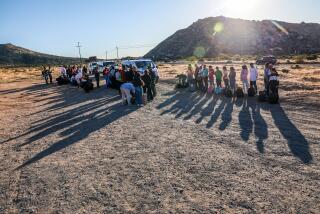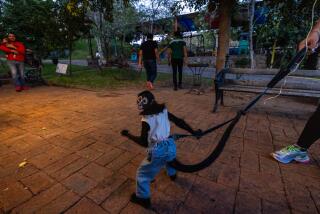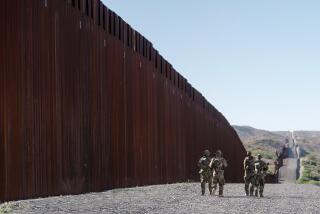Tourists Say Mexican Town Is Good for What Ails You
- Share via
LOS ALGODONES, Mexico — Let other Mexican border towns wager on factories and free trade. This burg is thriving on bad teeth and aging eyes.
The community of 10,000, the least known of the five border crossing points leading into California, has carved a booming niche by providing cut-rate dentistry and general medical care to the thousands of snowbirds who spend the winter in their trailers and RVs across the border in Imperial County and nearby Arizona.
Its market specialty is apparent as you drive the only lane crossing into town. Men in cowboy hats hand out fliers for prescription drugs on special at local pharmacies, while signs in English trumpet the dozens of dentists and eye doctors whose offices jam the few blocks closest to the border.
Discount medical care is common along the border, but in few places does it dominate as in Los Algodones. Here, dental offices outnumber restaurants 49 to nine. Add in the 26 pharmacies, 20 optical shops and 14 physicians offices, and you’ve got something of a mecca of medicine.
Mary Ann Johnson, a Wisconsin retiree spending her second winter in the area, said she and her husband come to Los Algodones for two reasons: “Our teeth and our glasses.” Johnson, who lacks dental insurance in the United States, figures she saved at least $500 by getting a crown and new glasses in Los Algodones recently.
From November through April, waiting rooms and sidewalks are crowded with senior citizens from as far away as Saskatchewan and Manitoba, pensioners paying cash for $130 root canals, discount eyeglasses and hormone pills going for a fraction of the cost charged north of the Mexican border.
That commerce, which by some estimates generates more than $100 million yearly, has changed the face of Los Algodones, once a collection of watering holes catering to young bar-hoppers from nearby Yuma. Shiny medical offices sit where bars used to, and freshly minted Mexican doctors and dentists arrive to open shops.
The successes in catering to the sans-a-belt set has some local boosters dreaming that building golf courses and RV parks might further raise the profile of a Baja California town that still doesn’t show up on many maps.
Jorge Garcia Salazar, a jeweler who is the equivalent of a mayor, said the town’s transformation began in 1982, when a peso devaluation invited a torrent of bargain-hunters with dollars. “We didn’t have this kind of tourism,” he said. “There weren’t as many new buildings. There weren’t as many shops.”
The town’s only notable exports are roofing tiles and bricks made at mom-and-pop factories that line the cotton fields south of the business district. The bustle around the dense cluster of medical offices and curio vendors gives way in a few blocks to unpaved streets of humble homes and roadside taco wagons.
The only outward sign of Los Algodones, tucked two miles south of Interstate 8 near the Arizona line, is a string of highway billboards advertising root canals, fast optical services and drugstores. On the U.S. side in California, a convenience store, a few fruit stands, an RV park and the border parking lot are all that make up unincorporated Andrade, part of the Quechan tribal reservation about 150 miles east of San Diego.
But just five miles from Yuma and a short drive from numerous trailer parks and RV encampments dotting the desert landscape in places such as Winterhaven, Calif., Los Algodones is strategically situated for its seasonal bonanza.
Seasonal Visitors
A trickle of summer visitors becomes a winter flood. Last month, about 275,000 people walked back into the United States from Los Algodones, according to U.S. Customs figures. That compares with 36,000 in August.
Customs tallied about 1.4-million crossings on foot, by far the most popular way to visit Los Algodones, during the year ending in September. Crossings are up about 10% this winter.
Among those making the trip on a recent Saturday was J.R. Banville, a retired Manitoba police officer, who was sipping a beer with a friend at a garden restaurant after an eye doctor’s appointment. He’s been heading south--his 31-foot trailer sits at a Yuma park called the Hitching Post--for a dozen winters, and has a mouthful of dental souvenirs from Los Algodones. Three years ago, a dentist pulled 23 teeth and made Banville upper and lower dentures.
Banville popped out the top plate to show off workmanship that he said is first-rate. “Completely satisfied,” he said. He estimates that the work cost less than a third of what it would have in Canada. That nation’s vaunted government-sponsored health system does not include dental care, so Canadian snowbirds seek the same savings as Americans by getting their teeth fixed in Mexico.
Some U.S. analysts find the south of the border trend a disturbing sign of how unaffordable health care and pharmaceuticals have become in the United States. And U.S. dentists caution that patients may pay for the price breaks with substandard care and nowhere to lodge complaints.
“As you could imagine, a patient going to a dentist in Mexico would not be subject to the same sort of legal recourse or regulations or, perhaps, infection control procedures that they would be able to access with a dentist in the United States,” said Lynne Randolph, spokeswoman for the California Dental Assn. She said the same considerations apply to any overseas dental care.
Los Algodones dentists chafe at suggestions that their work is inferior. They say most of the materials they use come from the same firms supplying dentists on the U.S. side. They insist that dentists in Los Algodones, many of whom advertise their alma mater in the front window, are as well-schooled and regulated as those in the United States.
“We’re on par. We have specialists who are very well-trained and professional,” said Bernardo Magana Padilla, an oral surgeon and dean of the town’s dentistry corps.
Magana and others concede that the explosion in the number of dentists has drawn some fly-by-night practitioners offering bargain basement rates, even by Los Algodones measures. But Magana said those belonging to the local dental college must comply with strict standards for professionalism.
Word of Mouth Advertising
The first dentist in town when he set up shop 30 years ago, Magana eventually found himself swamped with patients and recruited other dentists to join him. The ranks of dentists swelled since 1990 as word of low-cost care spread among the growing flocks of retirees descending on the region between El Centro and Yuma.
Magana’s thriving practice has expanded into a miniature empire. His complex now includes a pharmacy, coffee shop, perfumery and liquor store. He posts signs inviting tourists to a Mexican rodeo at his horse ranch outside town.
Magana’s clientele is 100% foreigners. Though cheap by U.S. and Canadian standards, the fees charged by most dentists are too steep for most Los Algodones residents, who rely on government-run clinics or go without dental care.
The burgeoning foreigners’ market remains a strong magnet for young dentists and physicians. This is the rookie season for Guadalupe Montoya Garcia, a recent graduate of the Autonomous University of Baja California in Mexicali. She and a partner opened their dental office in a new plaza in hopes of breaking into what for a dentist with a Mexican degree is a lucrative market.
It’s a building year--the daily patient load is still in the single digits. Still, Montoya said, “it’s the best place for dentists.”
Local officials say this brand of medical tourism provides more of an economic boon than assembly plants paying minimum wage. How many more dentists can be shoehorned in is anyone’s guess.
Garcia, the municipal leader, said growth will hinge on the quality of care and the continued favor of snowbirds with smiles to repair. “It all depends on supply and demand,” he said.
More to Read
Sign up for Essential California
The most important California stories and recommendations in your inbox every morning.
You may occasionally receive promotional content from the Los Angeles Times.










